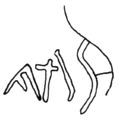VB·17: Difference between revisions
No edit summary |
No edit summary |
||
| Line 27: | Line 27: | ||
First published in {{bib|Bianchetti 1895}}: 68 (no. 5), 219. Examined for LexLep on 20<sup>th</sup> April 2024. | First published in {{bib|Bianchetti 1895}}: 68 (no. 5), 219. Examined for LexLep on 20<sup>th</sup> April 2024. | ||
Images in {{bib|Graue 1974}}: Taf. 59.9 (drawing), {{bib|Morandi 2004}}: 566, fig. 12.60 (drawing). | |||
Inscribed in the Latin alphabet on the foot of the cup along the rim (length 2.3 cm). Bianchetti and following him {{bib|Kretschmer 1905}}: 98, {{bib|Rhŷs 1913}}: 60 and Whatmough {{bib|PID}}: 118, no. 318, read {{w||atis}}; as observed by {{bib|Tibiletti Bruno 1978}}: 145 and Morandi, a second sigma, elongated on top, follows; in addition, the upper curve of the first sigma is extended into a half-moon shape {{c||C|d}}, and a horizontal line crosses it on top. It may be suspected that a writing mistake occurred here; which lines are erroneous, which are corrections, and what the writer's intention was, is unclear. Whatever the ending, ''atis''° may be a Celtic personal name (see the word page). | Inscribed in the Latin alphabet on the foot of the cup along the rim (length 2.3 cm). Bianchetti and following him {{bib|Kretschmer 1905}}: 98, {{bib|Rhŷs 1913}}: 60 and Whatmough {{bib|PID}}: 118, no. 318, read {{w||atis}}; as observed by {{bib|Tibiletti Bruno 1978}}: 145 and Morandi, a second sigma, elongated on top, follows; in addition, the upper curve of the first sigma is extended into a half-moon shape {{c||C|d}}, and a horizontal line crosses it on top. It may be suspected that a writing mistake occurred here; which lines are erroneous, which are corrections, and what the writer's intention was, is unclear. Whatever the ending, ''atis''° may be a Celtic personal name (see the word page). | ||
See also ''' | See also '''{{bib|Morandi 1999b}}: 323 f., no. 14'''. | ||
<p style="text-align:right;>[[User:Corinna Salomon|Corinna Salomon]]</p> | <p style="text-align:right;>[[User:Corinna Salomon|Corinna Salomon]]</p> | ||
{{bibliography}} | {{bibliography}} | ||
Revision as of 12:13, 3 August 2024
| Inscription | |
|---|---|
| Reading in transliteration: | atis(?)s |
| Reading in original script: | |
|
| |
| Object: | VB·17 Ornavasso (cup) |
| Position: | foot, outside |
| Direction of writing: | dextroverse |
| Script: | Latin script |
| Letter height: | 0.8–1.9 cm0.315 in <br />0.748 in <br /> |
| Number of letters: | 4 |
| Number of words: | 1 |
| Number of lines: | 1 |
| Workmanship: | scratched after firing |
| Condition: | complete |
|
| |
| Archaeological culture: | Roman imperial period [from object] |
| Date of inscription: | second quarter of 1st c. AD [from object] |
|
| |
| Type: | unknown |
| Language: | prob. Celtic |
| Meaning: | abbreviation (?) |
|
| |
| Alternative sigla: | Whatmough 1933 (PID): 318 Morandi 2004: 60 |
|
| |
| Sources: | Morandi 2004: 560 f. no. 60 |
Images
Commentary
First published in Bianchetti 1895: 68 (no. 5), 219. Examined for LexLep on 20th April 2024.
Images in Graue 1974: Taf. 59.9 (drawing), Morandi 2004: 566, fig. 12.60 (drawing).
Inscribed in the Latin alphabet on the foot of the cup along the rim (length 2.3 cm). Bianchetti and following him Kretschmer 1905: 98, Rhŷs 1913: 60 and Whatmough PID: 118, no. 318, read atis; as observed by Tibiletti Bruno 1978: 145 and Morandi, a second sigma, elongated on top, follows; in addition, the upper curve of the first sigma is extended into a half-moon shape ![]() , and a horizontal line crosses it on top. It may be suspected that a writing mistake occurred here; which lines are erroneous, which are corrections, and what the writer's intention was, is unclear. Whatever the ending, atis° may be a Celtic personal name (see the word page).
, and a horizontal line crosses it on top. It may be suspected that a writing mistake occurred here; which lines are erroneous, which are corrections, and what the writer's intention was, is unclear. Whatever the ending, atis° may be a Celtic personal name (see the word page).
See also Morandi 1999b: 323 f., no. 14.
Bibliography
| Bianchetti 1895 | Enrico Bianchetti, I sepolcreti di Ornavasso [= Atti della Società di Archeologia e Belle Arti della provincia di Torino 6], Torino: Paravia 1895. |
|---|

